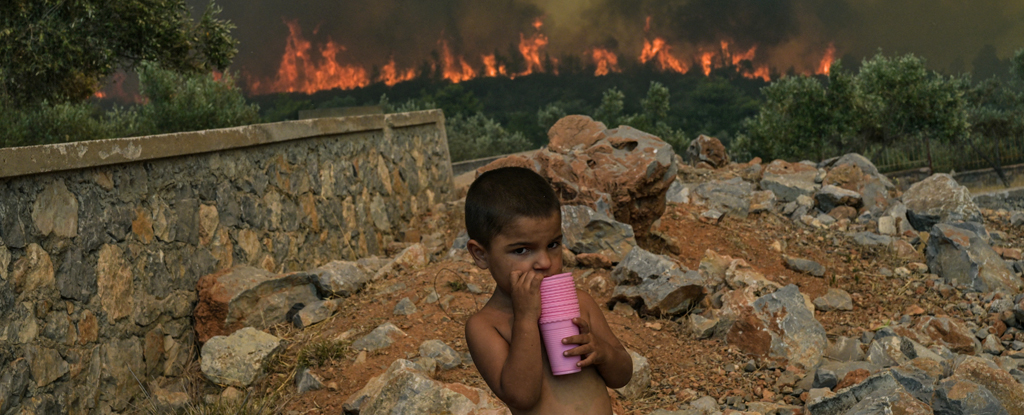Chemical records written in sea sponge skeletons suggest we passed the critical threshold of 1.5 °C of warming as early as 2010. If true, this places us close to – or even at – about 2 °C today.
Being ahead of schedule would explain why such extreme climate consequences have been walloping us far sooner than anticipated. Last year’s huge leaps in temperatures left researchers stunned and scrambling for theories to account for some mysterious missing factor to explain things.
“The differences are quite profound,” said University of Western Australia geochemist Malcolm McCulloch in a media briefing. “There is no real strong evidence that we’re on a serious pathway to reduce emissions. That’s the most concerning thing.”
With more and more of those incredibly annoying @JustStop_Oil #climate protesters being locked up, as you can see, the traffic is now flowing freely pic.twitter.com/l1BUHN69bm
— John Gibbons (@think_or_swim) July 21, 2023
McCulloch and colleagues used sea sponges as a kind of natural thermometer, to peer back through time to well before humanity’s industrial era, at a deeper layer of our ocean than previous measurements.
Sea sponge skeletons store different ratios of strontium compared to calcium depending on the temperature of the water they’re growing in. These animals grow very slowly, at about only 0.2 mm per year, which, given the size of some individuals, implies they could be up to 5,000 years old.
The sponges used by the researchers (Ceratoporella nicholsoni) are found 60 meters (197 ft) deep in a mixed layer of the ocean in the Caribbean. This depth, while still influenced by atmospheric warming, subdues the extreme fluctuations experienced closer to the surface, providing a better indication of overall average temperatures.
What’s more, this area is known to track global temperatures very closely, and is less influenced by natural fluctuations like ENSO than other ocean regions.
The researchers used about half a dozen sponges, estimated to be around 300-400 years old – providing researchers with a proxy temperature back into the 1700s.
The “new research shows that human-caused global warming started as early as the 1860s – several decades earlier than previously thought,” says climate scientist Georgy Falster from the Australian National University, who was not involved in the study.
“With the correction for the early-onset global warming, we have already overshot the 2015 Paris Agreement threshold of 1.5 ° above pre-industrial global temperature – and are on track to exceed 2 ° of warming by the late 2020s.”
McCulloch believes all the strange weather we’ve been experiencing, including massive heatwaves in Europe in regions that don’t usually have them, are what we’d expect at around 2 °C of post-industrial warming.
Ice-free summers in polar oceans are also expected to begin around a 2 ° threshold. We’re fast approaching that point.
❄️New paper with @CHolmesClimate exploring the record-breaking year that #Antarctic sea ice had in 2023:
Read it in @RMetS Weather here:https://t.co/VGgC4FGPt1 pic.twitter.com/s27ei2gEos
— Dr Ella Gilbert (@Dr_Gilbz) January 19, 2024
“A single new paleo record off the coast of Puerto Rico is a valuable addition to the large evidence of warming,” cautions University of Melbourne climate scientist Malte Meinshausen, who was not involved in the study. “But it is just that, one study among hundreds.”
McCulloch and team are keen to reproduce their study in other oceans, and have been attempting to do just that for years. Other proxies they’ve tried to use, like corals, have not provided the same level of accuracy though. Locating more of these deeper water sponges amidst the vast oceans has proven challenging.
But McCulloch is confident their sea sponge data is a better fit to observed data than the sea surface measurements we’ve been relying on so far. It matches more closely to CO2 records than the IPCC’s average does and also correlates to historic known geological events, such as past volcanic eruptions.
Previous models, including the IPCC, calibrated their data using measurements taken from ships since the 1920s. Early on, these measurements were not very systematic, often lacked data from the Southern Hemisphere, and contained a number of anomalies that still haven’t been entirely explained, such as inexplicable cooling during the 1900s of just the ocean but not the land.
This conflict is not present in the sea sponge data.
The new data set “appears to be well-correlated with global surface temperature trends,” agrees Australian National University climatologist Mark Howden, who was not involved in the study. “It shows that Industrial-era warming began in the mid 1860s, similar to previous research.”
Their results also contribute to the ongoing debate amongst climate scientists on whether the rate of warming has been increasing. The sea sponge data shows a strong signal of an increasing rate of warming.
“In my mind, the clock of climate change has been brought forward by about a decade, according to our findings,” explains McCulloch. “So things that we’re thinking would have happened 10 years hence, are actually happening now and the emissions are very high still. Unless we start to reduce them, these things are going to get progressively worse.”
McCulloch believes it’s still possible to keep warming to just over 2 °, which would be a heck of a lot safer than the 5 we’re currently hurtling towards on land.
“To some extent talking about 1.5 ° or 2 ° is somewhat irrelevant,” insists McCulloch, explaining targets need to be refocused to the amounts of fossil fuel reduced, not on temperature thresholds.
“Every additional increment of warming will make the outcomes worse. We have to change our focus to reductions. That’s the key thing.”
This study was published in Nature Climate Change.





